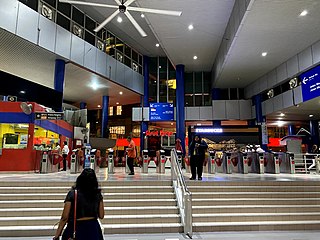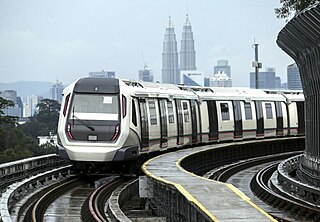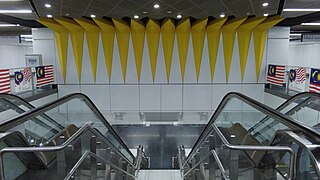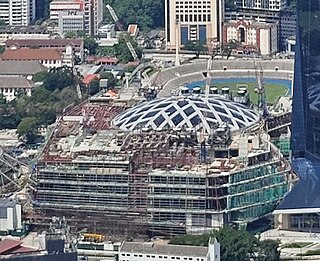
The KL Monorail Line is the only operational monorail system in Malaysia. Operated as part of the Rapid KL system by Rapid Rail, a subsidiary of Prasarana Malaysia, it is one of the components of the Klang Valley Integrated Transit System. The line is numbered 8 and coloured light green on official transit maps.

Rapid KL is a public transportation system owned by Prasarana Malaysia and operated by its subsidiaries Rapid Rail and Rapid Bus. The acronym stands for Rangkaian Pengangkutan Integrasi Deras Kuala Lumpur, which translates to Kuala Lumpur Rapid Integrated Transport Network in the Malay language. Rapid KL, with its 204.1 km (126.8 mi) of metro railway and 5.6 km (3.5 mi) of BRT carriageway, is part of the Klang Valley Integrated Transit System, operating throughout Kuala Lumpur and Selangor's satellite cities in the Klang Valley area.
Malaysian national projects are major national projects that are important to the development of Malaysia. The following is a list from Malaysian independence in 1957 to the present.

Pudu is a ward of Kuala Lumpur located along the Federal Route 1 Pudu Road. It houses Pudu Sentral and formerly Pudu Prison. Pudu Market is one of the largest wet markets in Kuala Lumpur. Adjacent to it is Jalan Pasar where there are shops selling electronics components and devices.

Masjid Jamek LRT station is a rapid transit station in Kuala Lumpur, Malaysia. It is the interchange station between two of Rapid KL's light rapid transit (LRT) systems, namely the LRT Ampang and Sri Petaling Lines and the LRT Kelana Jaya Line. The station is one of only two stations integrating the LRT lines, the other being Putra Heights station. The station is situated near and named after the Masjid Jamek in central Kuala Lumpur.

Pudu LRT station is an elevated rapid transit station situated in Pudu, Kuala Lumpur, Malaysia. The station serves a single line that is shared by both the Ampang Line and Sri Petaling Line. The station was opened on 16 December 1996, as part of the first phase of the STAR LRT system's opening, alongside 13 adjoining stations along the Sultan Ismail-Ampang route.

Dang Wangi LRT station is an underground metro station, in Kuala Lumpur, Malaysia, part of the Kelana Jaya line. The station was opened on 1 June 1999, as part of the line's second and latest extension, which includes the addition of 12 stations, and an underground line that the Dang Wangi station is connected to. The Dang Wangi station is one of only five underground stations in the Kelana Jaya Line.

Titiwangsa station is a rapid transit interchange station in Kuala Lumpur, Malaysia. The station is served by the LRT Ampang and Sri Petaling Lines, the KL Monorail Line and the MRT Putrajaya Line. The station allows seamless physical and fare integration between the four train lines.
Transport in Greater Kuala Lumpur includes a road network, a railway network, airports, and other modes of public transport. Greater Kuala Lumpur is conterminous with the Klang Valley, an urban conglomeration consisting of the city of Kuala Lumpur, as well as surrounding towns and cities in the state of Selangor. The Klang Valley has the country's largest airport, the Kuala Lumpur International Airport (KLIA), as well as the country's largest intermodal transport hub and railway station, Kuala Lumpur Sentral.

Chan Sow Lin station is an integrated metro station in Pudu, Kuala Lumpur, Malaysia. The station serves as an interchange station between the LRT Sri Petaling Line, LRT Ampang Line and the MRT Putrajaya Line. The station consists of an at-grade station for the Ampang and Sri Petaling lines, and an underground station for the Putrajaya line. Both stations are connected by an elevated pedestrian walkway, allowing paid-to-paid integration.

Imbi station is a Malaysian elevated train station on the monorail line that serves as a part of the Kuala Lumpur Monorail, located in Kuala Lumpur and opened alongside the rest of the train service on 31 August 2003. The station's similar location and proximity to a shopping district as the Bukit Bintang station means that the Imbi station is also one of the most heavily used stations along the KL Monorail line.
Bukit Nanas station is a Malaysian elevated monorail train station in Kuala Lumpur that serves as a part of the Kuala Lumpur Monorail. It was opened alongside the rest of the train service on 31 August 2003. This station was formerly called P. Ramlee Monorail station.

Sultan Ismail LRT station is a rapid transit station in Kuala Lumpur, Malaysia, operated by RapidKL served by the Ampang Line and Sri Petaling Line. This station was opened in 1996, along with 17 other LRT stations, as Phase 1 of the STAR LRT Line. It was the terminus of the Ampang-Sultan Ismail route before the extension to Sentul Timur. The Sultan Ismail LRT station stands between Sekolah Kebangsaan Lelaki Jalan Batu and Chung Kwok Primary School. The Malaysia's leading multinational conglomerate Sime Darby head office is opposite of this station. There is an artist impression of the station erected at SK Lelaki Jalan Batu.

Raja Chulan Monorail station is a Malaysian elevated monorail train station that serves as a part of the Kuala Lumpur Monorail, located in Kuala Lumpur and opened alongside the rest of the monorail service on 31 August 2003.

The LRT Ampang Line and the LRT Sri Petaling Line are medium-capacity light rapid transit (LRT) lines in the Klang Valley, Malaysia. The combined network comprises 45.1 kilometres (28.0 mi) of tracks with 36 stations and was the first railway in Malaysia to use standard-gauge track and semi-automated trains. The lines are operated as part of the Rapid KL system by Rapid Rail, a subsidiary of Prasarana Malaysia.

The Klang Valley Integrated Transit System is an integrated transport network that primarily serves the area of Klang Valley and Greater Kuala Lumpur. The system commenced operations in August 1995 with the introduction of commuter rail service on the existing rail between Kuala Lumpur and Rawang. The system have since expanded and currently consists of 11 fully operating rail lines in a radial formation; two commuter rail lines, six rapid transit lines, one bus rapid transit line and two airport rail links to the Kuala Lumpur International Airport's (KLIA) Terminal 1 and Terminal 2, and one temperarily suspended airport rail link to the Sultan Abdul Aziz Shah Airport. The system encompasses 528.4 kilometres (328.3 mi) of grade-separated railway with 197 operational stations.

The Merdeka MRT station is a mass rapid transit (MRT) underground station in Kuala Lumpur, Malaysia. It is one of the stations of the Klang Valley Mass Rapid Transit (KVMRT) MRT Kajang Line, formerly known as Sungai Buloh–Kajang Line and serves as an interchange station with Plaza Rakyat LRT station for LRT Ampang and Sri Petaling lines. The station was opened on 17 July 2017 under Phase Two operations of the MRT line.

Bukit Bintang is a Monorail station located in Bukit Bintang, Kuala Lumpur. As part of the KL Monorail line, it opened alongside the rest of the train service on 31 August 2003.

Bukit Bintang City Centre, also known as BBCC for short, is a 19.4 acres (7.9 ha) mixed-use development on the former site of Pudu Prison in Kuala Lumpur, Malaysia. The development is located at the south western end of Bukit Bintang, bordering with the Pudu district along Jalan Hang Tuah and Jalan Pudu.

118 Mall, previously known as MERDEKA @ 118, is a seven-storey glass domed shopping mall currently under construction located in Kuala Lumpur, Malaysia. The name "118" was derived from the number of floors in the Merdeka 118 tower which has a total of 118 storeys. The mall is currently being developed and owned by PNB Merdeka Ventures Sdn Bhd, a wholly-owned subsidiary of Permodalan Nasional Berhad (PNB), which is also the developer for the Merdeka 118 tower. The mall is situated at the foot of the tower and will directly serve its precinct.


















